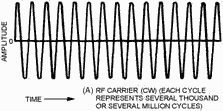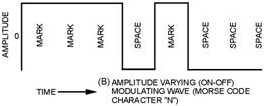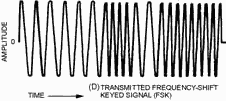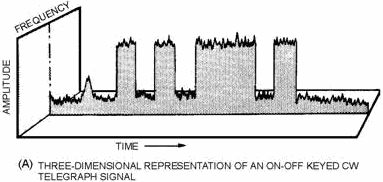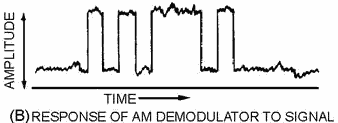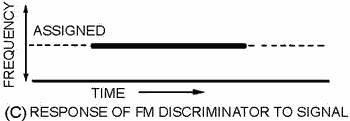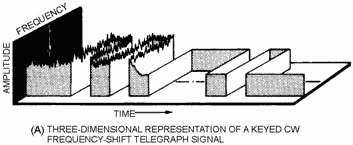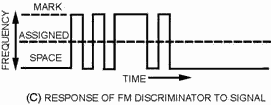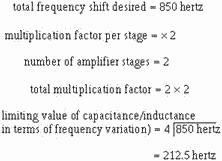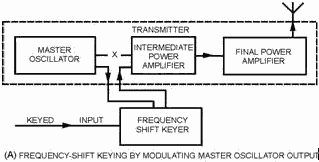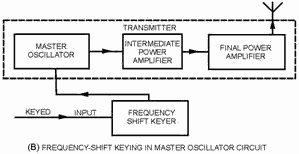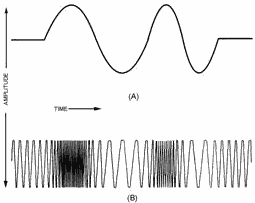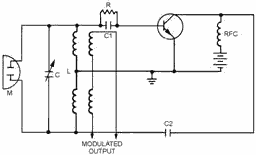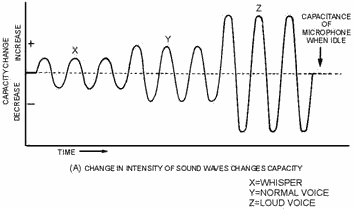Module 12 - Modulation Principles |
||||||||||||||||||||||||||||||||||||||||||||||||||
|
Module 12 − Modulation Principles
Pages i, 1−1, 1−11, 1−21, 1−31, 1−41, 1−51, 1−61, 1−71, 2−1, 2−11, 2−21, 2−31, 2−41, 2−51, 2−61, 3−1, 3−11, 3−21, 3−31, AI−1, Index, Assignment 1, 2
Chapter 2
ANGLE and PULSE MODULATION Learning Objectives
Upon completion of this chapter you will be able to: 1. Describe frequency-shift keying (FSK) and methods of providing this type of modulation. 2. Describe the development of frequency modulation ( FM ) and methods of frequency modulating a carrier. 3. Discuss the development of phase modulation (pm) and methods of phase modulating a carrier. 4. Describe phase-shift keying (PSK), its generation, and application. 5. Discuss the development and characteristics of pulse modulation. 6. Describe the operation of the spark gap and thyratron modulators. 7. Discuss the characteristics of a pulse train that may be varied to provide communications capability. 8. Describe pulse-amplitude modulation (PAM) and generation. 9. Describe pulse-duration modulation (PDM) and generation. 10. Describe pulse-position modulation (PPM) and generation. 11. Describe pulse-frequency modulation (PFM) and generation. 12. Describe pulse-code modulation (PCM) and generation. Introduction In chapter 1 you learned that modulation of a carrier frequency was necessary to allow fast communications between two points. As the volume of transmissions increased, a need for more reliable methods of communication was realized. In this chapter you will study angle modulation and pulse modulation. These two types of modulation have been developed to overcome one of the main disadvantages of amplitude modulation - susceptibility to noise interference. In addition, a special application of pulse type modulation for ranging and detection equipment will be discussed. 2-1 ANGLE MODULATION ANGLE MODULATION is modulation in which the angle of a sine-wave carrier is varied by a modulating wave. Frequency MODULATION ( FM ) and Phase MODULATION (pm) are two types of angle modulation. In frequency modulation the modulating signal causes the carrier frequency to vary. These variations are controlled by both the frequency and the amplitude of the modulating wave. In phase modulation the phase of the carrier is controlled by the modulating waveform. Let's study these modulation methods for an understanding of their similarities and differences. Frequency-MODULATION Systems In frequency modulation an audio signal is used to shift the frequency of an oscillator at an audio rate. The simplest form of this is seen in Frequency-SHIFT KEYING (FSK). Frequency-shift keying is somewhat similar to continuous-wave keying (CW) in AM transmissions. Frequency-Shift Keying Consider figure 2-1, views (A) through (D). View (A) is a radio frequency (rf) carrier which is actually several thousand or million hertz. View (B) represents the intelligence to be transmitted as MARKS and SPACES. Recall that in CW transmission, this intelligence was applied to the RF carrier by interrupting the signal, as shown in view (C). The amplitude of the RF alternated between maximum and 0 volts. By comparing views (B) and (C), you can see the mark/space intelligence of the Morse code character on the rf. The spacing of the waveform in view (D) is an example of the same intelligence as it is applied to the frequency instead of the amplitude of the rf. This is simple frequency-shift keying of the same Morse code character.
Figure 2-1A. - Comparison of ON-ofF and frequency-shift keying. RF CARRIER (CW) (EACH Cycle REPRESENTS SEVERAL THOUSand OR SEVERAL MILLION CycleS).
Figure 2-1B. - Comparison of ON-ofF and frequency-shift keying. Amplitude VARYING (ON-ofF) MODULATING WAVE (MORSE Code CHARACTER "N"). 2-2
Figure 2-1C. - Comparison of ON-ofF and frequency-shift keying. TRANSMITTED ON-ofF KEYED CW Signal.
Figure 2-1D. - Comparison of ON-ofF and frequency-shift keying. TRANSMITTED Frequency-SHIFT KEYED Signal (FSK). In FSK the output is abruptly changed between two differing frequencies by opening and closing the key. This is shown in view (D). For illustrative purposes, the spacing frequency in view (D) is shown as double the marking frequency. However, in practice the difference is usually less than 1,000 hertz, even when operating at several megahertz. You should also note that the limit of frequency shift is determined without reference to the amplitude of the keying signal in the FSK system. The frequency shift may be set at plus or minus 425 hertz from the allocated channel frequency. The total shift between mark and space would be 850 hertz. Either the mark or space may use the higher of the two frequencies. The upper frequency of the transmitted signal is usually the spacing interval and the lower frequency is the marking interval. COMPARING FSK and CW SignalS. - a comparison of on-off keyed CW (figure 2-2), (view (A), view (B), view (C)), and FSK (figure 2-3), (view (A), view (B), view (C)), signals will show clearly the principal features of FSK and give us a basis on which frequency modulation can be discussed. Let's use views (A), (B), and (C) of both figures to show the Morse code character "F" for an example. Figures 2-2 and 2-3 are graphic drawings of the two types of keying. Time and amplitude are known dimensions of AM; but to explain FSK properly, we have added the third dimension of frequency. 2-3
Figure 2-2A. - Comparison of AM and FM receiver response to an AM signal. THREE-DIMENSIONAL REPRESENTATION of an ON-ofF KEYED CW TELEGRAPH Signal.
Figure 2-2B. - Comparison of AM and FM receiver response to an AM signal. Response of AM DEModulator to Signal.
Figure 2-2C. - Comparison of AM and FM receiver response to an AM signal. Response of FM DIsCRIMINATOR to Signal.
2-4
Figure 2-3A. - Comparison of AM and FM receiver response to an FM signal. THREE-DIMENSIONAL REPRESENTATION of a Frequency-SHIFT KEYED TELEGRAPH Signal.
Figure 2-3B. - Comparison of AM and FM receiver response to an FM signal. Response of AM DEModulator to Signal.
Figure 2-3C. - Comparison of AM and FM receiver response to an FM signal. Response of FM DIsCRIMINATOR to Signal.
CW SignalS. - Since CW signals are of essentially constant frequency, there is no variation along the frequency axis in view (A) of figure 2-2. The complete intelligence is carried as variations in the amplitude of the signal. To receive the intelligence carried by such a signal, the receiving equipment must be able to scan the signal along the time and amplitude axes, which carry the information. When scanned along the time and amplitude axes [shown in view (B)], the intelligence appears as large changes in amplitude. If the circuit were perfect, these variations would be from 0 amplitude to some maximum value (established by transmitter power, distance, and so forth) depending on whether the key were open or closed. However, interfering components of energy caused by atmospherics, interfering stations, and 2-5 electrical machinery appear as additional variations along the amplitude axis. When these amplitude variations approach or exceed the variation caused by the keyed intelligence, the signal is blanked out by interference. We have all heard this happen on our AM radios during storms or when near operating machinery. View (C) of figure 2-2 represents the same signal when scanned along the time and frequency axes as it would be in an FM receiver. Variations in signal amplitude have no effect on the frequency and no intelligence can be received. Note that the noise and interference components have also been suppressed so that they have little effect on the received signal. Thus, if the intelligence variations were impressed as changes along the frequency axis, and the receiving equipment were designed to respond to this type of signal, then the effects of noise and interference would be practically eliminated. Frequency-shift keyed circuits fulfill these conditions. FSK SignalS. - In FSK the RF signal is shifted in frequency (not amplitude) between "key-open" and "key-closed" conditions. The signal amplitude remains essentially constant. View (A) of figure 2-3 represents the letter "F" keyed as a shift in frequency between mark and space. The normal frequency condition with the key open is a space. Recall that this may be either the lower or higher frequency. When the key is closed, the frequency instantly changes to the mark value and remains constant during the marking interval. Opening the key again returns the frequency to the space frequency. Midway between the mark and space frequencies is the assigned channel frequency. Also shown in view (A) is the variation along the amplitude axis caused by the same noise and interference mentioned earlier. The right-hand portion of view (A) illustrates the elimination of this noise by the receiving equipment. View (B) clearly shows that scanning the signal along the amplitude and time axes reproduces no amplitude variations from signal interference. However, if the scanning is accomplished along the frequency and time axes, the intelligence is reproduced, as shown in view (C). By this system, the intelligence can be recovered at the receiving station in its original form; it will be nearly unaffected by conditions in the radio path other than fading. As a matter of fact, FSK resists the effects of fading better than CW. Frequency-SHIFT KEYING. - In its simplest form, frequency-shift keying of a transmitter can be accomplished by shunting a capacitor (or an inductor) and key (in series) across the oscillator circuit. By locking the normal key of the transmitter and operating only the oscillator circuit key, you can change the oscillator frequency. The shift in frequency between mark (key-closed) and space (key-open) conditions is determined by the effect of the additional capacitance (or inductance) on the oscillator frequency. The frequency multiplication factor in the transmitter amplifiers must be taken into consideration when determining the oscillator frequency shift. Thus, if the desired shift is the conventional 850 hertz at the transmission frequency, and this frequency is four times the oscillator frequency (that is, doubled in two stages), then the effect of the additional capacitance (or inductance) on the oscillator must be limited to 212.5 hertz as shown below: 2-6
Frequency-shift keyers are, of course, more complicated than this simple illustration would seem to show, but the basic principles are the same. Still, the keyer does change the oscillator frequency by a certain number of cycles. Further, this change must be correlated with the multiplication factor of the transmitter to cause the desired shift between mark and space frequencies. Methods of Frequency SHIFTING. - Frequency-shift keyers operate on either of two general principles. First, the keyer may take the output of the transmitter's master oscillator and modulate it with the output of another oscillator that is frequency-shift keyed. This action will result in two frequencies that are used to excite the first amplifier stage of the transmitter. This system is illustrated in view (A) of figure 2-4. View (B) illustrates the second method of frequency-shift keyer operation. In this method the transmitter's master oscillator is itself shifted in frequency by the mark and space impulses from the keyer unit.
Figure 2-4A. - Two methods of frequency-shift keying (FSK). Frequency-SHIFT KEYING BY MODULATING MASTER Oscillator Output. 2-7
Figure 2-4B. - Two methods of frequency-shift keying (FSK). Frequency-SHIFT KEYING IN MASTER Oscillator Circuit.
ADVANTAGES of FSK OVER AM. - Frequency-shift keying is used in all single-channel, radiotelegraph systems that use automatic printing systems. The advantage of FSK over on-off keyed CW is that it rejects unwanted signals (noise) that are weaker than the desired signal. This is true of all FM systems. Also, since a signal is always present in the FSK receiver, automatic volume control methods may be used to minimize the effects of signal fading caused by ionospheric variations. The amount of inherent signal-to-noise ratio improvement of FSK over AM is approximately 3 to 4 dB. This improvement is because the signal energy of FSK is always present while signal energy is present for only one-half the time in AM systems. Noise is continuously present in both FSK and AM, but is eliminated in FSK reception. Under the rapid fading and high-noise conditions that commonly exist in the high frequency (HF) region, FSK shows a marked advantage over AM. Overall improvement is sometimes expressed as the RATIO of TRANSMITTED PowerS required to give equivalent transmission results over the two systems. Such a ratio varies widely, depending on the prevailing conditions. With little fading, the ratio may be entirely the result of the improvement in signal-to-noise ratio and may be under 5 dB. However, under severe fading conditions, large amounts of power often fail to give good results for AM transmission. At the same time, FSK may be satisfactory at nominal power. The power ratio (FSK versus AM) would become infinite in such a case. Another application of FSK is at low and very low frequencies (below 300 kilohertz). At these frequencies, keying speeds are limited by the "flywheel" effect of the extremely large capacitance and inductance of the antenna circuits. These circuits tend to oscillate at their resonant frequencies. Frequency-shifting the transmitter and changing the antenna resonance by the same keying impulses will result in much greater keying speeds. As a result, the use of these expensive channels is much more efficient.
Q-1. What are the two types of angle modulation?
Q-2. Name the modulation system in which the frequency alternates between two discrete values in response to the opening and closing of a key?
Q-3. What is the primary advantage of an FSK transmission system?
Frequency Modulation In frequency modulation, the instantaneous frequency of the radio-frequency wave is varied in accordance with the modulating signal, as shown in view (A) of figure 2-5. As mentioned earlier, the amplitude is kept constant. This results in oscillations similar to those illustrated in view (B). The number 2-8 of times per second that the instantaneous frequency is varied from the average (carrier frequency) is controlled by the frequency of the modulating signal. The amount by which the frequency departs from the average is controlled by the amplitude of the modulating signal. This variation is referred to as the Frequency DEVIATION of the frequency-modulated wave. We can now establish two clear-cut rules for frequency deviation rate and amplitude in frequency modulation:
Figure 2-5. - Effect of frequency modulation on an RF carrier.
• AMOUNT of Frequency SHIFT Is PROPORTIONAL to The Amplitude of The MODULATING Signal (This rule simply means that if a 10-volt signal causes a frequency shift of 20 kilohertz, then a 20-volt signal will cause a frequency shift of 40 kilohertz.) • RATE of Frequency SHIFT Is PROPORTIONAL to The Frequency of The MODULATING Signal (This second rule means that if the carrier is modulated with a 1-kilohertz tone, then the carrier is changing frequency 1,000 times each second.) Figure 2-6 illustrates a simple oscillator circuit with the addition of a condenser microphone (M) in shunt with the oscillator tank circuit. Although the condenser microphone capacitance is actually very low, the capacitance of this microphone will be considered near that of the tuning capacitor (C). The frequency of oscillation in this circuit is, of course, determined by the LC product of all elements of the circuit; but, the product of the inductance (L) and the combined capacitance of C and M are the primary frequency components. When no sound waves strike M, the frequency is the RF carrier frequency. Any excitation of M will alter its capacitance and, therefore, the frequency of the oscillator circuit. Figure 2-7 illustrates what happens to the capacitance of the microphone during excitation. In view (A), the audio- frequency wave has three levels of intensity, shown as X, a whisper; Y, a normal voice; and Z, a loud voice. In view (B), the same conditions of intensity are repeated, but this time at a frequency twice that of view (A). Note in each case that the capacitance changes both positively and negatively; thus the frequency of oscillation alternates both above and below the resting frequency. The amount of change is determined by the change in capacitance of the microphone. The change is caused by the amplitude of the sound wave exciting the microphone. The rate at which the change in frequency occurs is determined by 2-9 the rate at which the capacitance of the microphone changes. This rate of change is caused by the frequency of the sound wave. For example, suppose a 1,000-hertz tone of a certain loudness strikes the microphone. The frequency of the carrier will then shift by a certain amount, say plus and minus 40 kilohertz. The carrier will be shifted 1,000 times per second. Now assume that with its loudness unchanged, the frequency of the tone is changed to 4,000 hertz. The carrier frequency will still shift plus and minus 40 kilohertz; but now it will shift at a rate of 4,000 times per second. Likewise, assume that at the same loudness, the tone is reduced to 200 hertz. The carrier will continue to shift plus and minus 40 kilohertz, but now at a rate of 200 times per second. If the loudness of any of these modulating tones is reduced by one-half, the frequency of the carrier will be shifted plus and minus 20 kilohertz. The carrier will then shift at the same rate as before. This fulfills all requirements for frequency modulation. Both the frequency and the amplitude of the modulating signal are translated into variations in the frequency of the RF carrier.
Figure 2-6. - Oscillator circuit illustrating frequency modulation.
Figure 2-7A. - Capacitance change in an oscillator circuit during modulation. CHANGE IN INTENSITY of SOUND WAVES CHANGES CAPACITY. 2-10
Related Pages on RF Cafe - Quadrature (I/Q) Modulator Sideband Suppression - Modulation Principles, AM Modulation, NEETS - Modulation Principles, FM Modulation, NEETS |
||||||||||||||||||||||||||||||||||||||||||||||||||
